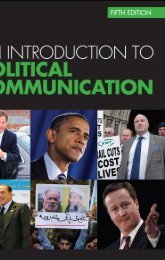Understanding global security - Peter Hough
Understanding global security - Peter Hough
Understanding global security - Peter Hough
Create successful ePaper yourself
Turn your PDF publications into a flip-book with our unique Google optimized e-Paper software.
MILITARY THREATS TO SECURITY FROM STATES<br />
the armed intervention by the USA and a number of allies in South Korea to aid their<br />
resistance struggle against invasion by Communist North Korea.<br />
The Cold War went through distinct phases where hostility between East<br />
and West became more or less intense. Writers differ in the precise dating of these<br />
periods of a thawing or freezing in Cold War relations but there is broad agreement<br />
on three main phases (see Table 2.2).<br />
Table 2.2 Phases of the Cold War<br />
First Cold War 1945–69<br />
1945–49 Onset The Cold War could be said to have begun with the declaration of the<br />
Truman doctrine in 1947 but hostilities in US–USSR relations can be<br />
traced back to the closing stages of the Second World War and even<br />
before.<br />
1949–53 Confrontation In 1949 the USSR developed the atom bomb and NATO was formed,<br />
setting the parameters for two armed camps and a massive arms build<br />
up. The Berlin blockade brought the two sides near to war when the<br />
USSR challenged the US–UK–French control of West Berlin. China<br />
underwent Communist revolution in 1949 and the following year<br />
fought with the North Koreans against the USA and her allies.<br />
1953–62 Slight thaw The death of Stalin and ending of the Korean War (in stalemate) in<br />
1953 heralded a lessening of tension. The 1955 Geneva Summit was<br />
the first attempt at Arms Control talks between the USA and USSR.<br />
An acceptance of spheres of influence by both sides was again<br />
evident; the USA did not come to the aid of Hungary when the USSR<br />
intervened in 1956 and the USSR did not assist Communist Cuba in<br />
resisting a US-sponsored intervention in 1960. Confrontation was not<br />
ended however; the Warsaw Pact was formed in 1955 by the USSR<br />
as an East European military alliance to rival NATO and the USA<br />
and USSR came as close as they ever did to war in 1962 with the<br />
Cuban Missile Crisis when the USSR attempted to station warheads<br />
on the island.<br />
1963–69 Coexistence The Cuban missile crisis was resolved with a deal whereby the USA<br />
removed missiles from Turkey in exchange for USSR not stationing<br />
weapons on Cuba. The very real possibility of nuclear war in 1962<br />
prompted improved dialogue between the two superpowers. Arms<br />
Control agreements were initiated and the logic of deterrence set in<br />
to US–Soviet relations, with both sides recognizing the other’s right to<br />
parity in military terms as a means of guaranteeing peace through<br />
the balance of terror. There was still military conflict in the Cold War,<br />
however, as evidenced by the US role in the Vietnam War from 1961<br />
to 1975 supporting South Vietnam against Communist North Vietnam.<br />
26
















